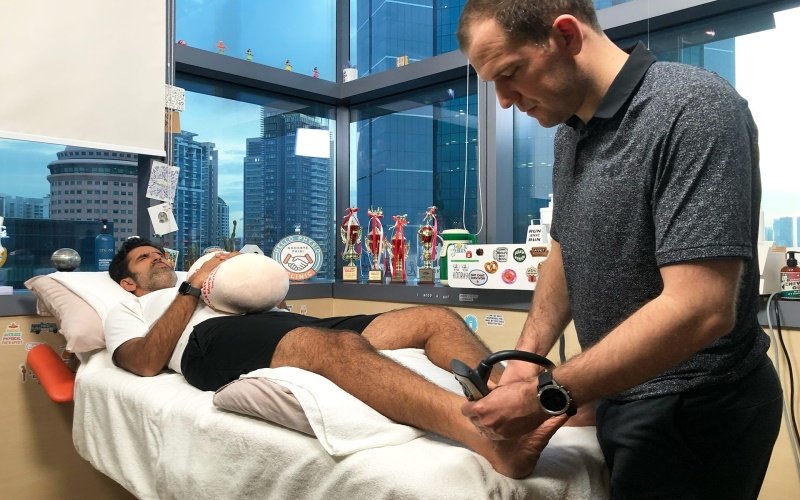Ankle sprains are one of the most common musculoskeletal injuries, affecting both athletes and individuals in everyday life. In Singapore’s active population, these injuries can be particularly frequent. Fortunately, a wide range of treatment options are available to manage a sprained ankle effectively. This article provides a comprehensive guide to sprained ankle treatment in Singapore. Alternatively, you can check this link: https://physioactive.sg/our-services/physiotherapy/injury-treatment .
A sprained ankle occurs when the ligaments connecting the bones in the ankle joint are stretched or torn. A sprain can result from a few common situations. A misstep can be readily caused by uneven terrain such as loose gravel, potholes, or cobblestones. Sports like basketball, soccer, or tennis that require sudden direction changes, jumping, or rotating place a lot of strain on our ankles. Other things besides outside influences may also have a role.
Ankles that are not strong enough or flexible enough to withstand strains are more prone to injury. Exercises that target the ankle muscles can be neglected, leading to undeveloped and less supporting ankle muscles, which can result in this weakness. Furthermore, a history of ankle sprains can weaken the ligaments, increasing the risk of further injury. Unsuitable footwear is another factor.
Ankle vulnerability might result from shoes that don’t provide enough stability, support, or fit correctly. Similarly, having balance problems increases your chance of falling and spraining your ankle. These problems might be brought on by inner ear abnormalities, age-related decline, or certain neurological illnesses. The severity of a sprained ankle can range from mild to severe, depending on the extent of ligament damage.
Symptoms of ankle sprain typically include the following:
1. Pain
- the most immediate and noticeable symptom that can range from mild discomfort to a sharp, throbbing sensation, often localized around the outer ankle or on the sides of the joint.
2. Swelling
- swelling occurs around the sprained area
- degree of swelling can vary depending on the severity of the sprain
3. Bruising
- broken blood vessels beneath the skin often cause discoloration around the
- might not appear immediately but can develop over a few hours or days following the injury.
4. Tenderness
- the injured area will likely be very sensitive to touch even with gentle pressure
5. Difficulty Bearing Weight
- putting weight on the affected ankle might be difficult or even impossible depending on the severity of the sprain
- the ankle might feel unstable or “give way” when attempting to walk especially in severe cases
6. Reduced Range of Motion
- sprain might limit the normal movement of your ankle joint
- activities like flexing your foot upwards or downwards might become painful or restricted
7. Popping Sound
- in some severe sprains, a popping or snapping sound might be heard at the time of the injury, potentially indicating a significant ligament tear
The initial focus of sprained ankle treatment in Singapore, as elsewhere, follows the RICE principle which means:
Rest: Limiting weight-bearing activities allows the ligaments to heal properly. Depending on the severity, crutches or a walking boot might be recommended.
Ice: Applying ice packs to the affected area for 15-20 minutes at a time, several times a day, can help reduce inflammation and pain.
Compression: Wrapping the ankle with an elastic bandage can provide support and minimize swelling.
Elevation: Elevating the ankle above the heart level helps reduce swelling and discomfort.
Following the initial management steps, various treatment options are available in Singapore to promote healing and recovery from a sprained ankle. These can be broadly categorized as conservative and surgical approaches.
Conservative Treatment:
- Over-the-counter pain medication: Pain relievers like paracetamol or ibuprofen can help manage pain and inflammation.
- Physical therapy: A physiotherapist in Singapore can design a personalized exercise program to improve flexibility, strengthen the ankle muscles, and restore normal movement. This plays a vital role in preventing future sprains.
- Bracing and taping: Wearing a brace or using kinesio taping can provide support and stability to the ankle joint during the healing process.
- Crutches: In severe cases, crutches might be needed to prevent weight-bearing on the injured ankle.
Surgical Treatment (In severe cases):
In rare instances where the sprain involves a complete ligament tear or there is significant instability in the joint, surgery might be necessary to repair the damaged ligaments. This is typically an outpatient procedure performed by an orthopedic surgeon.
A visit to the doctor is recommended in some circumstances, even though many ankle sprains heal with appropriate home care. Some signs that you should get medical help are as follows:
- If the pain is unbearable or swelling doesn’t improve within a few days
- If you can’t put any weight on your ankle for four steps
- If the ankle appears visibly deformed
- Numbness or tingling in the foot or toes
- If you experience frequent ankle sprains
Singapore offers a wide range of medical care options for sprained ankle treatment. Here are options on where treatments are offered:
- Public Hospitals: Singapore’s public healthcare system provides excellent treatment options at subsidized rates. You can visit a polyclinic or a larger hospital’s emergency department depending on the severity of the injury.
- Private Clinics: Numerous private clinics in Singapore specialize in sports medicine or general practice and can effectively treat sprained ankles.
- Physiotherapy Clinics: Physiotherapists in Singapore can play a crucial role in sprained ankle rehabilitation after an initial evaluation by a doctor.
Treatment expenses for sprained ankles in Singapore vary based on the healthcare practitioner and the degree of the ailment. Public hospitals are often the most economical options, whereas private clinics may be more expensive. Many Singaporeans have medical insurance, which might help with treatment costs.
The recovery time for a sprained ankle varies according to the severity of the injury. Mild sprains often heal in a few days to a week, however serious sprains can take several weeks. Severe sprains with ligament tears might take months to fully recover. Following the specified treatment plan and undergoing physical therapy can drastically shorten recovery time.
Wearing proper footwear, warming up and cooling down during exercise, regular exercise that strengthens ankle and leg muscles can improve stability, and being mindful and cautious when traversing uneven terrain, loose gravel, or slippery surfaces can all significantly reduce the risk of sprained ankles. Sprained ankles are frequent in Singapore. However, with appropriate therapy and a proactive approach to rehabilitation, most people can fully recover and resume their normal activities.
Physioactive
Camden Medical Centre
#11-05 Singapore 248649
6235 2647



